Creating a captivating and professionally formatted catalog is essential to showcase your products and services effectively. No one wants to sift through the entire collection to locate what they need. The catalog serves as both a guide and a reservation system. However, to achieve this, it's crucial to choose a format that allows for easy editing and ensures a polished look when shared across platforms. Hence, PDF format is considered the best choice, as it presents ideas in a structured and visually appealing manner.
Nevertheless, selecting software that supports PDF creation and offers a range of features can be overwhelming. This guide provides detailed instructions on how to create a catalog in PDF in UPDF, helping you organize your content into an engaging and professional layout. Click the button below to start!
Windows • macOS • iOS • Android 100% secure
Part 1. Why are Catalogs Developed in PDF Nowadays?
Before understanding how to create a catalog in PDF, it's necessary to explore why this format has become a modern staple for catalogs. As we explore the benefits, you'll see why PDFs are the go-to solution for professional and engaging catalogs.
- PDFs preserve the layout and design of your catalog to ensure that fonts, images, and spacing remain intended across all devices and platforms. This trait of PDF is crucial to maintaining a professional appearance while avoiding formatting issues.
- In terms of accessibility, PDFs can be opened on any device, from desktops to smartphones. With this widespread support, this format is a reliable choice for sharing documents anywhere.
- PDFs can include interactive elements like clickable links, videos, and forms to enhance user engagement. Hence, these features of PDF can make your catalog more dynamic and user-friendly.
- They offer various security options such as encryption and password protection to control, access, or modify the document. This level of security helps protect sensitive information and ensures that the catalog remains intact and confidential.
Part 2. Create the Perfect PDF Catalog from Scratch
To generate a perfect PDF catalog from scratch, you'll need a versatile tool that simplifies the design and publishing process. One such tool is UPDF which offers comprehensive editing features to insert images and links in catalog to enhance visual appeal and provides easy access to additional information. Furthermore, while exploring how to make catalog in PDF through UPDF, one can embed images in the PDF file to engage with the products.
For some reason, if users want to trim excess margins or unwanted areas, there is a Crop Pages tool to get cleaner and more focused catalog presentations. While doing so, one can personalize the page margins, constraints proportions and page size to ensure the catalog fits specific design requirements. Since background matters a lot in catalog presentation, you can make use of its page tool to tailor the backdrop that reinforces branding.
Ultimate Guide on How to Create PDF Catalog with UPDF
Many users seek how to make a PDF catalog in Photoshop, but little do they know that the procedure can be daunting because of its crowded interface. Therefore, switching to UPDF is advised as it comes with a wide range of features that can be accessible, even for amateurs. Thus, explore the sequential guide to create a compelling catalog in snap of fingers:
Step 1. Add a Blank Page to Generate a Catalog
Launch UPDF on your operating system.
Windows • macOS • iOS • Android 100% secure
Launch UPDF and click "File" in the top-left corner, then select "Blank Page" to start creating your catalog. At this step, you can adjust page size, page color, and other settings. Alternatively, you can drag and drop a downloaded catalog template directly into UPDF for editing.
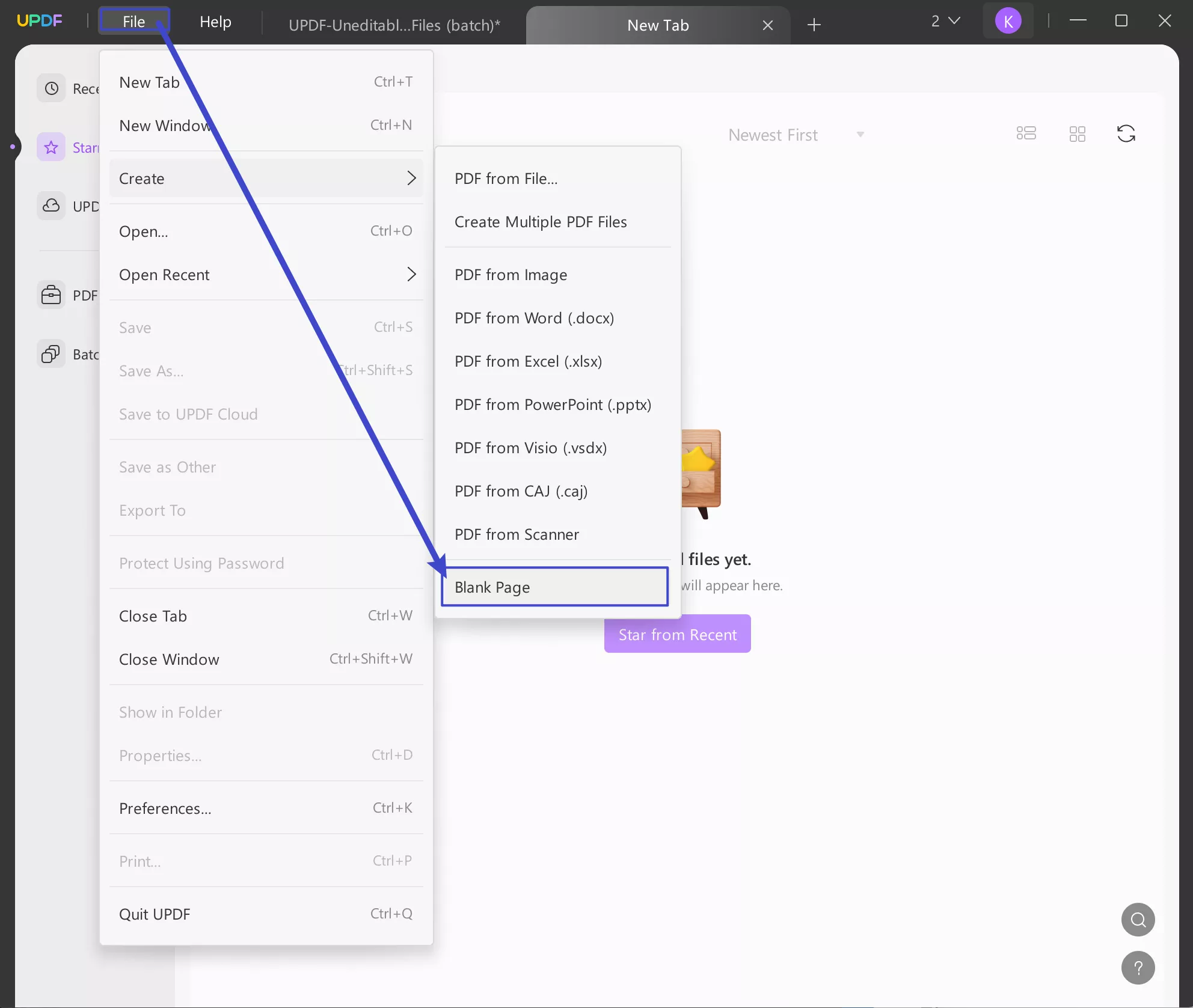
Step 2. Add and Edit Background
Backgrounds can enhance the outlook of your catalog if added. lead to the "Page Tools" tab from the left column. Next, you will have to select the "Background" option on the top bar. tap on the "Add" button to open the editing panel on the left. Decide if you want to add a "Color," "Image," or a "PDF" background to your document. As you select it, you can set the ratio and opacity of the background that you are adding.
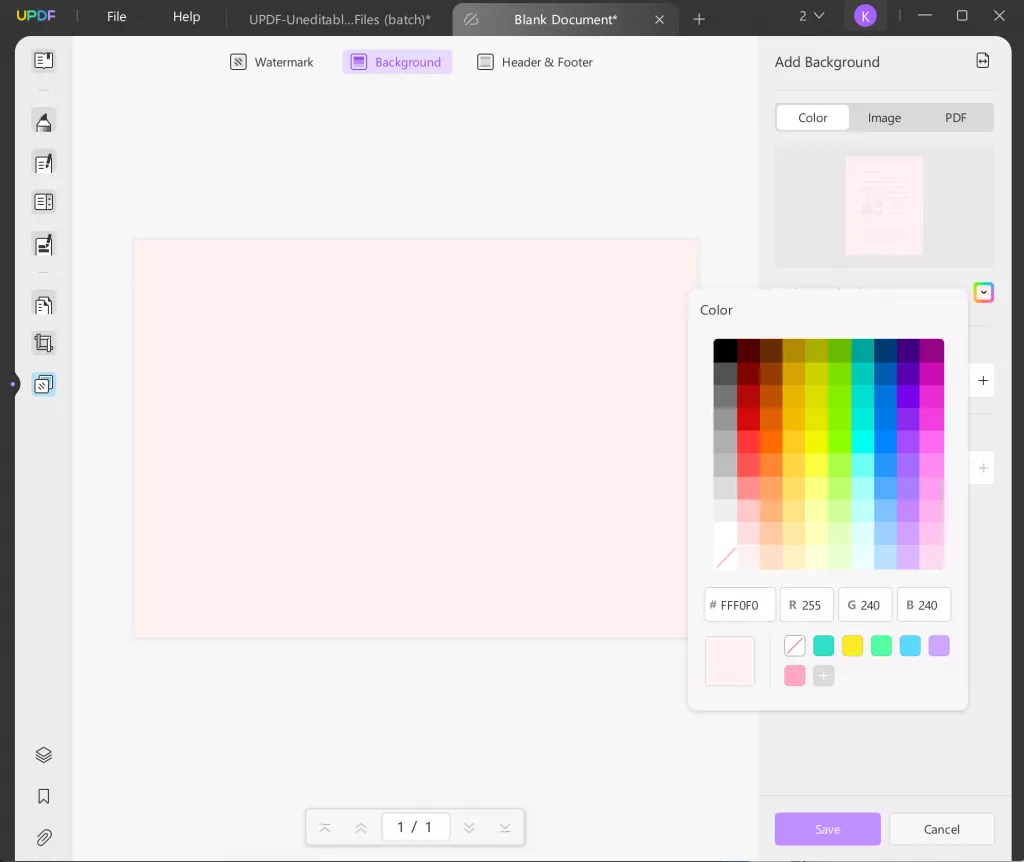
Step 3. Edit Your Catalog
UPDF is a powerful PDF editor that allows you to edit text, images, links, and other elements within a PDF. Enter editing mode by clicking the "Edit PDF" option on the left toolbar. Click the "Text", "Image" or "Link" icon in the top toolbar to:
- Set the style of the text you are adding, including the font, font size, color, and alignment of the text, etc.
- Adjust your product images' position and size as needed.
- Link your official website URL to this document for convenient customer ordering.
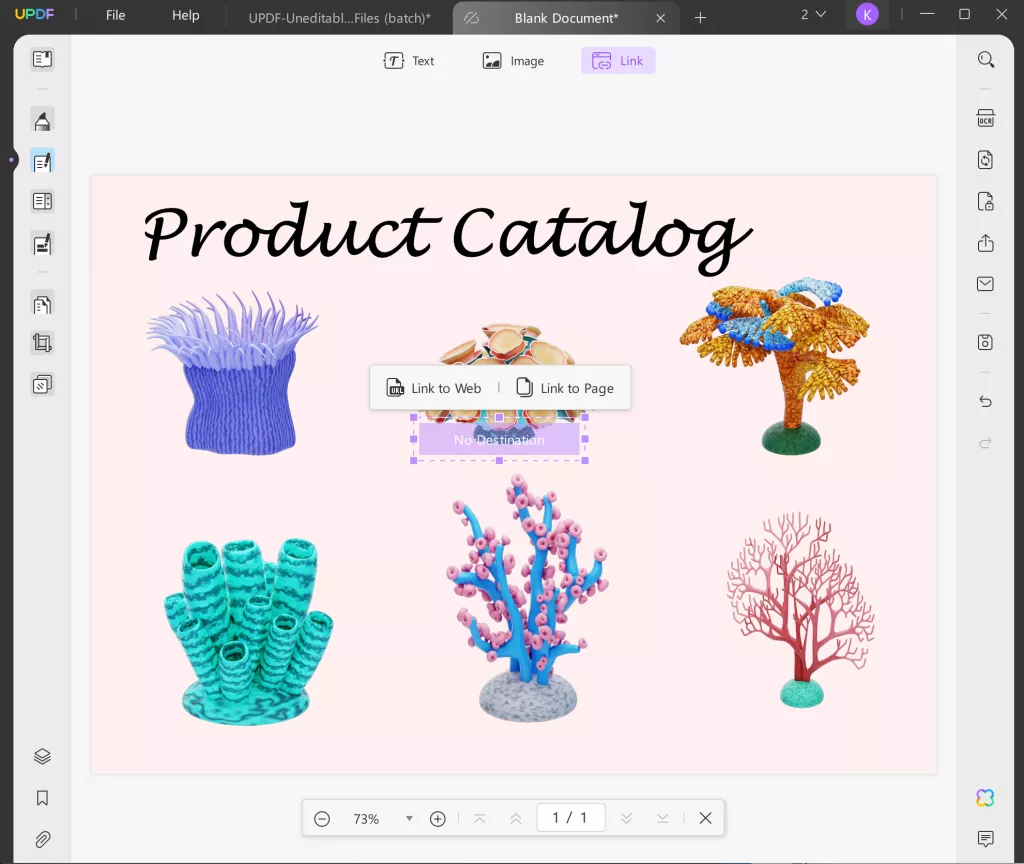
Step 4. Annotate Your Catalog
UPDF provides Text Markups, including Highlight, Strikethrough, Underline, Squiggly. To add text markups, click the "Comment" menu on the top toolbar. Choose any of the above markups and place them on your document.
In addition, UPDF supports drawing rectangles, ovals, lines, and arrows. Just click the "Shapes" icon and select the drawing tools in the drop-down menu.
You can also select the "Sticker" or "Stamp" icon from the top menu to to add stickers or create a stamp.
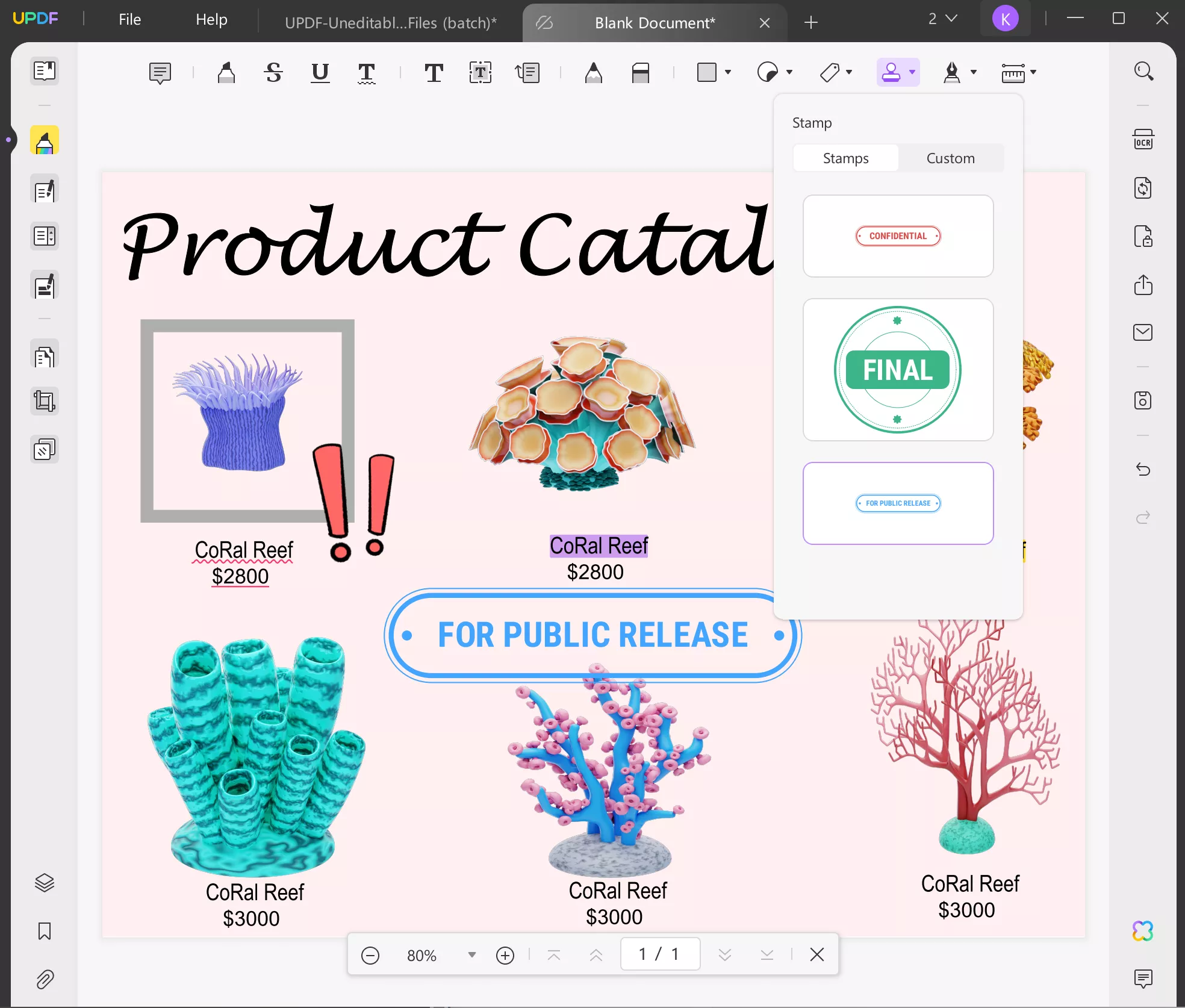
Step 5. Add Interactive Button
You can add interactivity to PDF in UPDF to let customers or collaborators engage with the catalog. Interactive elements in UPDF includes text field, check box, radio button, and more. Tap the "Prepare Form" option from the left sidebar and choose the relevant option from the top menu bar. Double-click to change its name or select a button style.
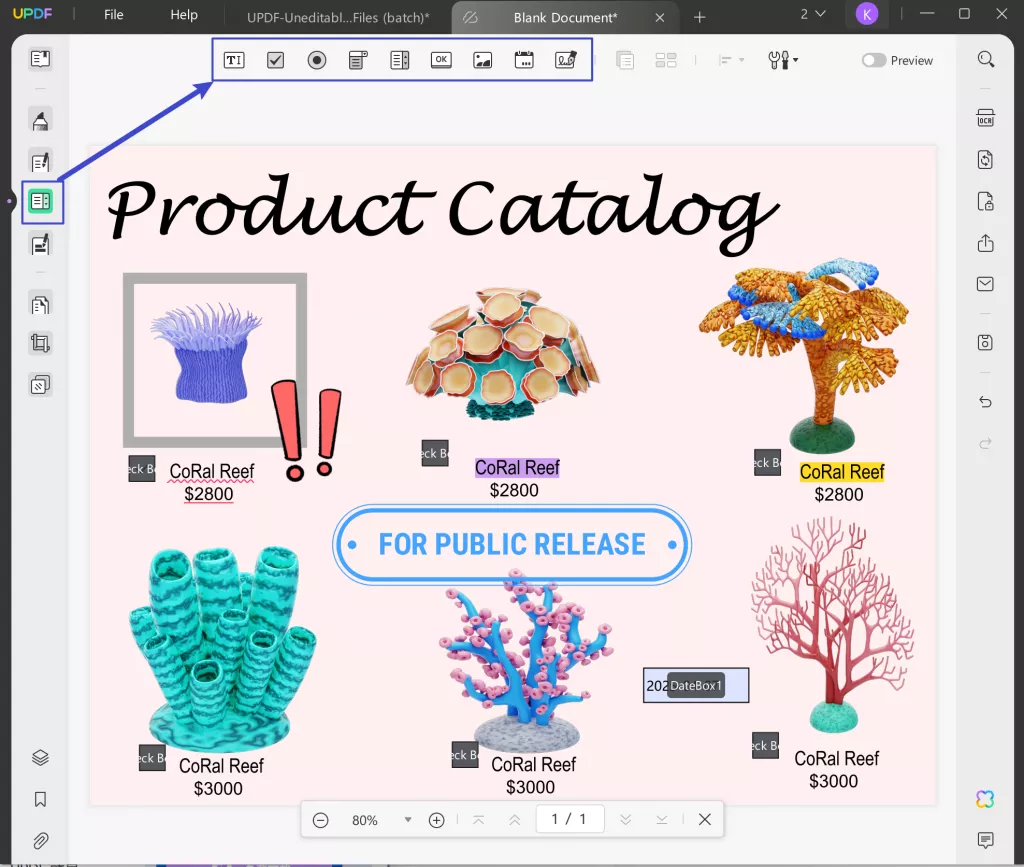
Step 6. Share Your Catalog
Once you have created an interactive catalog, UPDF lets you share it directly. Here’s what you can do:
Click "Share this File with Others" from the right. Choose "Share a Link" and click "Create". Then, copy the link or share it via QR Code. If you want to send the PDF to a lot of people at once, select "Share with Others" to share via email. Add multiple email addresses separated with "Enter". Then click "Send".
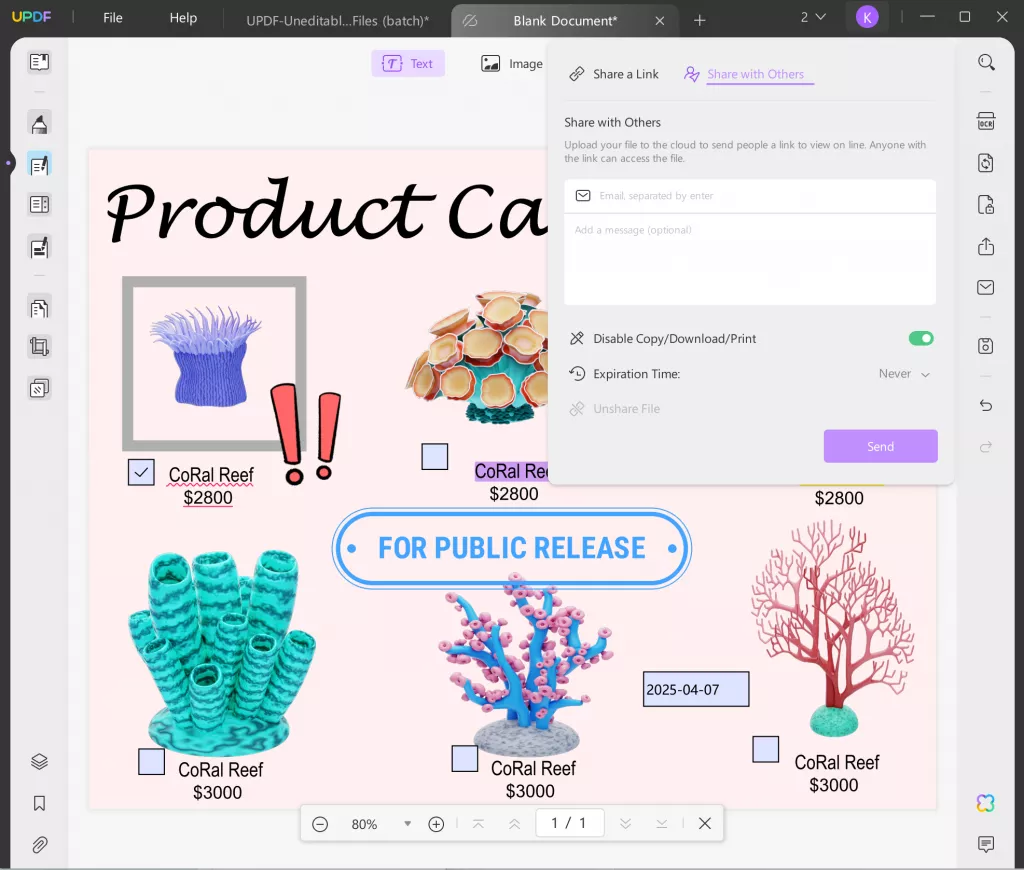
Tip
If you have many products to showcase and introduce, you can also add bookmarks to your catalog. Also Read: How to Add Bookmarks to PDF >>
Conclusion
To sum up, creating a catalog in PDF format involves several key steps, including designing a cohesive layout, adding interactive features, and ensuring security. By following best practices, you can produce a professional and effective catalog that engages your audience. To learn an easy and efficient way of how to make a catalog in PDF, explore why UPDF is the best tool available by clicking the button below.
Windows • macOS • iOS • Android 100% secure
 UPDF
UPDF
 UPDF for Windows
UPDF for Windows UPDF for Mac
UPDF for Mac UPDF for iPhone/iPad
UPDF for iPhone/iPad UPDF for Android
UPDF for Android UPDF AI Online
UPDF AI Online UPDF Sign
UPDF Sign Read PDF
Read PDF Annotate PDF
Annotate PDF Edit PDF
Edit PDF Convert PDF
Convert PDF Create PDF
Create PDF Compress PDF
Compress PDF Organize PDF
Organize PDF Merge PDF
Merge PDF Split PDF
Split PDF Crop PDF
Crop PDF Delete PDF pages
Delete PDF pages Rotate PDF
Rotate PDF Sign PDF
Sign PDF PDF Form
PDF Form Compare PDFs
Compare PDFs Protect PDF
Protect PDF Print PDF
Print PDF Batch Process
Batch Process OCR
OCR UPDF Cloud
UPDF Cloud About UPDF AI
About UPDF AI UPDF AI Solutions
UPDF AI Solutions AI User Guide
AI User Guide FAQ about UPDF AI
FAQ about UPDF AI Summarize PDF
Summarize PDF Translate PDF
Translate PDF Explain PDF
Explain PDF Chat with PDF
Chat with PDF Chat with image
Chat with image PDF to Mind Map
PDF to Mind Map Chat with AI
Chat with AI User Guide
User Guide Tech Spec
Tech Spec Updates
Updates FAQs
FAQs UPDF Tricks
UPDF Tricks Blog
Blog Newsroom
Newsroom UPDF Reviews
UPDF Reviews Download Center
Download Center Contact Us
Contact Us








 Lizzy Lozano
Lizzy Lozano 

 Enrica Taylor
Enrica Taylor 
